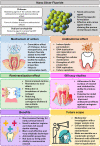The Anticariogenic Efficacy of Nano Silver Fluoride
- PMID: 35845391
- PMCID: PMC9283724
- DOI: 10.3389/fbioe.2022.931327
The Anticariogenic Efficacy of Nano Silver Fluoride
Abstract
Dental caries is a common chronic disease, and anyone can be at threat of it throughout their lifespan. In school-aged children, dental caries is the most frequent disease related with oral health. Contemporary dental caries management focuses on non-restorative, non-invasive, and micro-invasive therapeutic techniques that effectively eliminate the caries progression at the lesion level and decrease the loss of healthy tooth structure. One of these strategies is to use caries apprehending agents with antibacterial and remineralizing characteristics. Due to recent regulatory approval in the United States, the use of silver diamine fluoride (SDF) for the therapy of dental caries has received substantial interest. SDF has successfully prevented and reversed both primary tooth caries and permanent teeth root caries. Even though SDF is an effective anti-caries agent, but it is associated with certain drawbacks like gum irritation, metallic taste, and irreversible dark stains on applying on cavities. As an alternative agent Nano Silver Fluoride (NSF) is preferable because it performs like SDF without tooth staining. It has comparable preventive and antibacterial activities as SDF. Further, it is ergonomic, economic and safe in children and adults. The current article aims to highlight the superior properties of NSF as a better anti-caries agent outstripping the limitations of discoloration of SDF.
Keywords: anticaries agent; colloid; nano silver fluoride; silver diamine fluoride; varnish.
Copyright © 2022 Pushpalatha, Bharkhavy, Shakir, Augustine, Sowmya, Bahammam, Bahammam, Mohammad Albar, Zidane and Patil.
Conflict of interest statement
The authors declare that the research was conducted in the absence of any commercial or financial relationships that could be construed as a potential conflict of interest.
Figures
References
-
- Abo El Soud A. A., Elsaied H. A., Omar S. M. M. (2020). Comparative Evaluation of the Effects of Silver Diamine Fluoride (Commercial and Lab Prepared) versus Nano Silver Fluoride on Demineralized Human Enamel Surfaces (In Vitro Study). Egypt. Dent. J. (Oral Med. X-Ray, Oral Biol. Oral Pathology)) 66, 153–163. 10.21608/edj.2020.77529 - DOI
-
- Al-Nerabieah Z., Arrag E. A., Comisi J. C., Rajab A. (2020). Effectiveness of a Novel Nano-Silver Fluoride with Green Tea Extract Compared with Silver Diamine Fluoride: A Randomized, Controlled, Non-inferiority Trial. Ijdos 7, 753–761. 10.19070/2377-8075-20000148 - DOI
-
- Arnaud M., Junior P. C., Lima M. G., e Silva A. V., Araujo J. T., Gallembeck A., et al. (2021). Nano-silver Fluoride at Higher Concentration for Caries Arrest in Primary Molars: A Randomized Controlled Trial. Int. J. Clin. Pediatr. Dent. 14 (2), 207–211. 10.5005/jp-journals-10005-1920 - DOI - PMC - PubMed
Publication types
LinkOut - more resources
Full Text Sources
Research Materials


